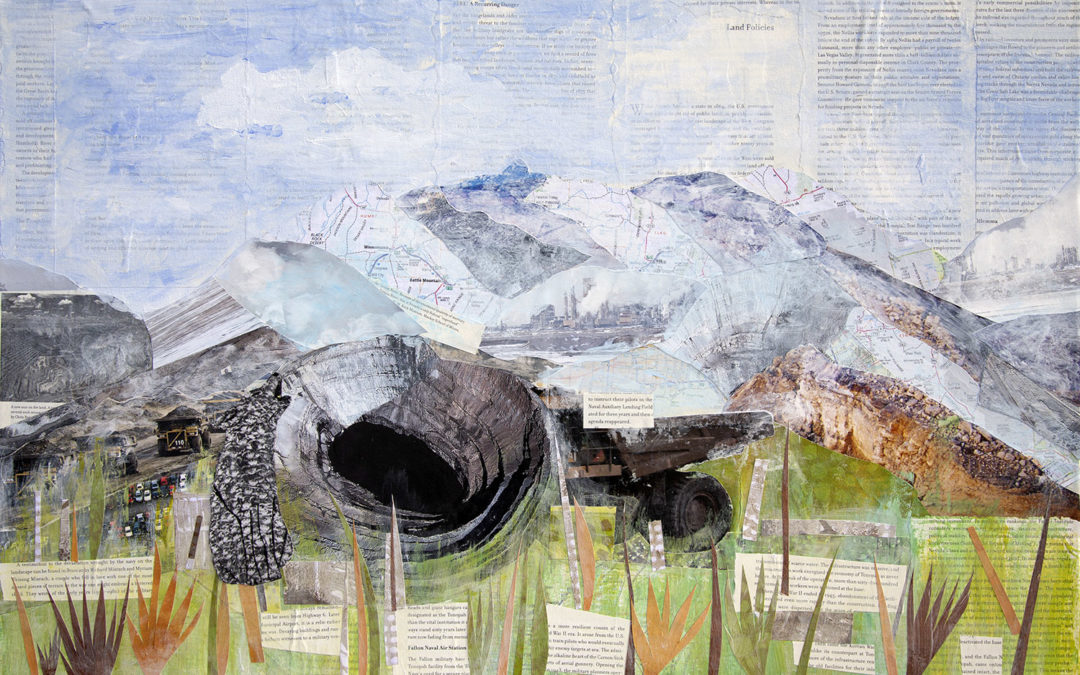Before getting involved with environmental activism, I barely gave Nevada much of a thought. I visited only once, reluctantly, to go to Las Vegas on a trip with a friend, on the condition that we spend at least some of our time exploring outside the city. In the end, we did far too little exploring beyond the garish, otherworldly horror show that is Las Vegas, and so, after leaving that city I swore I’d never visit the state again.
When I later visited the Sierra Mountains, just over the border on the Nevada side and discovered the incredible beauty of where the mountains meet the sagebrush sea I had to entirely rethink what I thought of the state. The way the sagebrush runs into the hills which run into the mountains reminds me a little, in a strange way, of the heather covered moors, and the treeless hills and mountains of my native Scotland. Just as Scotland was stripped bare of its native Scots pine, ash, oak, and birch for agriculture, livestock, timber, and fuel, Nevada has likewise been deforested of native piñon woodlands, primarily for mining and smelting.
Nevada became a state in 1864 during a silver mining bonanza that began in 1859. Every early mine in Nevada required millions of board feet of timber to shore up the tunnels dug for the mines (this was the era before open pit mining began), and to produce the vast amounts of charcoal required to smelt the ore extracted from these mines. Before blast furnaces depended on coke made from coal, they depended on charcoal made from wood. And so, every early mine in Nevada ate up thousands of square miles of piñon and juniper trees, feeding them to the ever-hungry furnaces to smelt the silver, gold, and iron ores being pulled from the ground.
As other kinds of metals and minerals were discovered in the rock of Nevada, tunnel mining was replaced with open pit mining. Open pit mining requires first removing the “overburden”, as the trees, plants, soil, and beings who live there are euphemistically called, thus flaying the land before eviscerating it. As James Hulse writes in Nevada’s Environmental Legacy: Progress or Plunder, “The open-pit method ripped massive gouges in the mountain with gigantic mechanized shovels, then trucked the overburden to the surface to spread it across adjacent hillsides. The scars of seven decades of open-pit mining are prominent features along U.S. Highway 50…”
The dust from copper mines, laced with uranium and other toxins resulting from the mining and smelting, blew across the Nevada landscape landing in people’s homes, their water supplies, and their lungs. Deadly chlorine gas regularly wafted into the atmosphere from processing ore from magnesium mines. Mercury belched from the smokestacks of gold refineries continues to contaminate the air and water of people all across Nevada and beyond. To quote again from Hulse: “The EPA has estimated that between 1998 and 2001, Nevada mining operations released more than twenty-one thousand pounds of mercury into the air annually, making Nevada the nation’s leading source of atmospheric mercury pollution.” Exposure to mercury can result in muscle weakness, numbness in the extremities, skin rashes, anxiety, memory problems, or, with a high exposure, even death.
Mining is only one of many ways Nevada, and all the beings, human and non-human, who live there are being sacrificed to the god of progress. For after the miners came the military men. Nellis Air Force Base opened in southern Nevada just before the attack on Pearl Harbor. Military expansion in Nevada continued through World War II, the Vietnam War, and, of course, the Cold War. Hundreds of square miles in Nevada were used for storing, testing, and exploding ammunition, along with hundreds of missile silos housing missiles both nuclear and not. Military installations in Nevada are used for bombing ranges, nuclear tests, flight test areas, and military exercises. Forty-nine military installations, each with at least one hazardous site are dotted all over the state. A region 65 miles west of Las Vegas is known as the world’s “hottest, most deadly nuclear garbage dump.”
Perhaps most pernicious of all are the ongoing, deadly impacts from the Nevada Test Site: the world’s most active center for testing nuclear devices. Nuclear testing sites cover a huge swathe of terrain in the state–1.27 million acres of land. Nevada was chosen by the military for nuclear testing because they saw the land as “wasteland”, not understanding the complexity and fecundity of the desert and high plains ecosystems they were destroying, or the multi-millennia long fallout these tests would have on every living being. Radiation from nuclear testing doesn’t just affect the living beings in Nevada; it affects everyone in the country, and probably the world as it spread thousands of miles from the nuclear blasts. One hundred above ground nuclear tests conducted between 1951 and 1963 has been linked to an increase in deaths from thyroid cancer in the United States.
Rivers of water that begin life as snow in the mountain ranges flows down the valleys as surface water forming much needed lakes, streams, and dribbles for those who live there to drink from. The scarce rain that falls in Nevada has collected into aquifers over millions of years in the rock beneath the surface. All are contaminated with the waste of almost two centuries of industrialism in Nevada. And all of this water is needed by the living beings in Nevada to drink, for water is life, and without clean water, we are done. But this precious water is mined to feed refineries, smelters, logging operations, industrial agriculture, slurry pits, and giant sin cities that shouldn’t exist. It is diverted and dammed into lakes made for human consumption and recreation where it is quickly polluted and evaporates into the dry Nevada air. Many of Nevada’s water basins are in overdraft, meaning more water is being used than is being replaced, despite decades of water management regulations. Nevada is in an intense legal battle with Utah over water. Hoover Dam, one of many dams that is complicit in the murder of the Colorado River, and the water from the Lake Meade reservoir it creates, supplies electricity and water to Las Vegas. Each year there are more people who want the water from the Colorado River, and each year the river is murdered just a little bit more as her lifeblood is sucked dry.
I have learned much about Nevada since my visit to Las Vegas twenty-odd years ago. I appreciate its beauty, and recoil from the horror of its devastation. I see Max and Will doing their best to protect one of the few truly wild places left in the state, and I am moved by their determination, and that of all the activists and campers and regional locals, indigenous and not, who have come forward to aid in the effort. Faced with the sad and tortured history of abuse this land has endured, it is comforting to know there are so many people who still care.
Image: The Evisceration of Nevada, a collage by Elisabeth Robson


This is SO good. Thank you. Learned so much.